A three-way catalyst (TWC) makes exhaust gas less harmful by oxidizing hydrocarbons and carbon monoxide and reducing nitrogen oxides. Usually, platinum-group metals, such as Rh, Pd, and Pt, are used in TWCs. Finding alternatives to these metals would make TWCs less costly and more sustainable. Researchers have investigated the crystal-structure/activity relationship of metal-oxide catalysts to develop catalysts without platinum-group metals. So far, most studies have discussed only the bulk properties of metal oxides, e.g., the band structure, as factors that control catalytic activity.
Atsushi Satsuma, Nagoya University and Kyoto University, both Japan, Kakuya Ueda, Nagoya University, and colleagues have clarified the causes of the activities of iron oxides with different structures, i.e., spinel, corundum, or perovskite structures. The team focused not only on the larger, periodic structure but also looked at the local coordination structure. Theoretical calculations for the periodic structure and those in local systems provide complementary information. The calculations under periodic boundary conditions estimate the strength of the interaction between iron oxide catalyst and adsorbate, while molecular orbital calculations make it possible to assess local orbital interactions.
Spinel iron oxide (γ‐Fe2O3, pictured top right) has a much higher NO reduction activity than that of iron oxide with other structures. This work showed that iron oxide with a spinel structure has a higher NO reduction activity due in part to its high NO adsorption energy compared with other iron oxide catalysts. Molecular orbital calculations indicate that the high NO affinity of the spinel structure is due to the involvement of not only σ orbitals but also π orbitals (pictured bottom right) in the NO adsorption. This work shows that the local coordination structures are important to understand the activity of these catalysts.
- Structure–Activity Relationship of Iron Oxides for NO Reduction in the Presence of C3H6, CO, and O2,
Kakuya Ueda, Junya Ohyama, Kyoichi Sawabe, Atsushi Satsuma,
Chem. Eur. J. 2019.
https://doi.org/10.1002/chem.201902994




